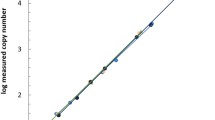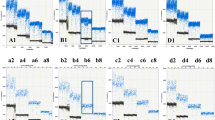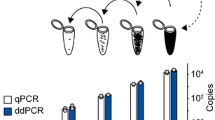Abstract
In recent years, digital polymerase chain reaction (dPCR), a new molecular biology technique, has been gaining in popularity. Among many other applications, this technique can also be used for the detection and quantification of genetically modified organisms (GMOs) in food and feed. It might replace the currently widely used real-time PCR method (qPCR), by overcoming problems related to the PCR inhibition and the requirement of certified reference materials to be used as a calibrant. In theory, validated qPCR methods can be easily transferred to the dPCR platform. However, optimization of the PCR conditions might be necessary. In this study, we report the transfer of two validated qPCR methods for quantification of maize DAS1507 and NK603 events to the droplet dPCR (ddPCR) platform. After some optimization, both methods have been verified according to the guidance of the European Network of GMO Laboratories (ENGL) on analytical method verification (ENGL working group on “Method Verification.” (2011) Verification of Analytical Methods for GMO Testing When Implementing Interlaboratory Validated Methods). Digital PCR methods performed equally or better than the qPCR methods. Optimized ddPCR methods confirm their suitability for GMO determination in food and feed.





Similar content being viewed by others
References
Europen Network of GMO Laboratorie (2015) Definition of minimum performance requirements for analytical methods of GMO testing.
(2003). Regulation (EC) No 1829/2003 of the European Parliment and of the Council of 22 September 2003 on Genetically Modified Food and Feed Official Journal of European Union.
Institute for Health and Consumer Protectio (2011) Compendium of reference methods for GMO analysis. [Internet]. Luxembourg: Publications Office [cited 2017 Jul 25]. Available from: https://doi.org/10.2788/16086
PN-EN ISO/IEC 17025:2005, General requirements for the competence of testing and calibration laboratories.
Regulation (EC) No 882/2004 of the European Parliament and of the Council of 29 April 2004. Official Journal of the European Union.
Broeders SRM, De Keersmaecker SCJ, Roosens NHC(2012) How to deal with the upcoming challenges in GMO detection in food and feed. Journal of Biomedicine & Biotechnology; 2012:1–11.
Marmiroli, N., Maestri, E., Gullì, M., Malcevschi, A., Peano, C., Bordoni, R., et al. (2008). Methods for detection of GMOs in food and feed. Anal Bioanal Chem. Oct, 392(3), 369–384.
Corbisier, P., Bhat, S., Partis, L., Rui Dan Xie, V., & Emslie, K. R. (2010). Absolute quantification of genetically modified MON810 maize (Zea mays L.) by digital polymerase chain reaction. Analytical and Bioanalytical Chemistry, 396(6), 2143–2150.
Dong, L., Meng, Y., Sui, Z., Wang, J., Wu, L., & Fu, B. (2015). Comparison of four digital PCR platforms for accurate quantification of DNA copy number of a certified plasmid DNA reference material. Scientific Reports, 25(5), 13174.
Milavec, M., Dobnik, D., Yang, L., Zhang, D., Gruden, K., & Žel, J. (2014). GMO quantification: valuable experience and insights for the future. Analytical and Bioanalytical Chemistry, 406(26), 6485–6497.
Lievens A, Jacchia S, Kagkli D, Savini C, Querci M. (2016) Measuring digital PCR quality: performance parameters and their optimization. Chan KYK, editor. PLoS One; 11(5):e0153317.
Commision Regulation (EU) No 619/2011 of 24 June 2011 Laying down the methods of sampling and analysis for the official control of feed as regards presence of genetically modified material for which an authorisation procedure is pending or the authorisation of which has expired. Official Journal of European Union.
Demeke, T., & Jenkins, G. R. (2010). Influence of DNA extraction methods, PCR inhibitors and quantification methods on real-time PCR assay of biotechnology-derived traits. Analytical and Bioanalytical Chemistry, 396(6), 1977–1990.
Morisset D, Štebih D, Milavec M, Gruden K, Žel J. (2013) Quantitative analysis of food and feed samples with droplet digital PCR. Heazlewood JL, editor. PLoS One; 8(5):e62583.
Köppel, R., & Bucher, T. (2015). Rapid establishment of droplet digital PCR for quantitative GMO analysis. European Food Research and Technology, 241(3), 427–439.
Fu, W., Zhu, P., Wang, C., Huang, K., Du, Z., Tian, W., et al. (2015). A highly sensitive and specific method for the screening detection of genetically modified organisms based on digital PCR without pretreatment. Scientific Reports, m5, 12715.
Köppel, R., Bucher, T., Frei, A., & Waiblinger, H.-U. (2015). Droplet digital PCR versus multiplex real-time PCR method for the detection and quantification of DNA from the four transgenic soy traits MON87769, MON87708, MON87705 and FG72, and lectin. European Food Research and Technology, 241(4), 521–527.
Dobnik, D., Spilsberg, B., Bogožalec Košir, A., Holst-Jensen, A., & Žel, J. (2015). Multiplex quantification of 12 European Union authorized genetically modified maize lines with droplet digital polymerase chain reaction. Analytical Chemistry, 87(16), 8218–8226.
ENGL working group on “Method Verification.” (2011). Verification of analytical methods for gmo testing when implementing interlaboratory validated methods. Publications Office of the European Union.
Mazzara, Marco, Cordeil, Stephane, Van den Eede, Guy. (2005) Event-specific method for the quantification of maize line NK603 using real-time PCR. Jt Res Cent Inst Health Consum Prot Biotechnol GMOs Unit- Community Ref Lab.
Mazzara, Marco, Cordeil, Stephane, Van den Eede, Guy. (2005) Event-specific method for the quantitation of maize line TC1507 using real-time PCR. Jt Res Cent Inst Health Consum Prot Biotechnol GMOs Unit- Community Ref Lab.
Gerdes, L., Iwobi, A., Busch, U., & Pecoraro, S. (2016). Optimization of digital droplet polymerase chain reaction for quantification of genetically modified organisms. Biomol Detect Quantif, 7, 9–20.
Holst-Jensen, A., & Berdal, K. G. (2004). The modular analytical procedure and validation approach and the units of measurement for genetically modified materials in foods and feeds. Journal of AOAC International, 87(4).
BioRad. Droplet digital PCR applications guide.
Arumuganathan, K., & Earle, E. D. (1991). Nuclear DNA content of some important plant species. Plant Molecular Biology Reporter, 9(3), 208–218.
Robin JD, Ludlow AT, LaRanger R, Wright WE, Shay JW. (2016) Comparison of DNA quantification methods for next generation sequencing. Sci Rep [Internet], 6(1). Available from: http://www.nature.com/articles/srep24067
Author information
Authors and Affiliations
Corresponding author
Ethics declarations
Conflict of interest
The authors declare that they have no conflict of interest.
Rights and permissions
About this article
Cite this article
Grelewska-Nowotko, K., Żurawska-Zajfert, M., Żmijewska, E. et al. Optimization and Verification of Droplet Digital PCR Even-Specific Methods for the Quantification of GM Maize DAS1507 and NK603. Appl Biochem Biotechnol 185, 207–220 (2018). https://doi.org/10.1007/s12010-017-2634-x
Received:
Accepted:
Published:
Issue Date:
DOI: https://doi.org/10.1007/s12010-017-2634-x




